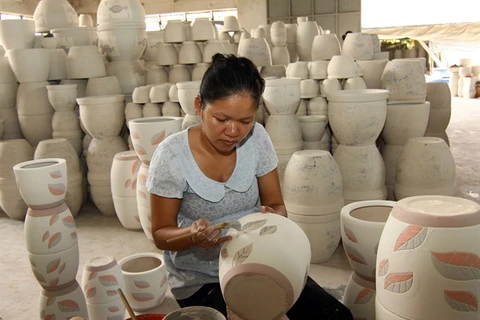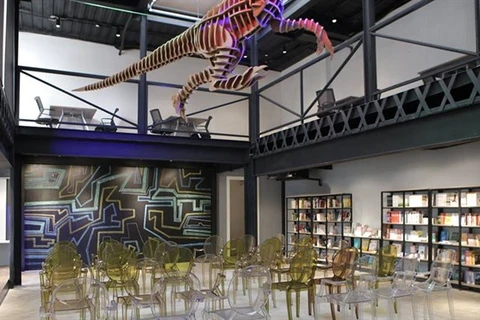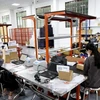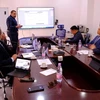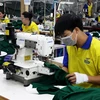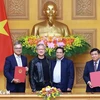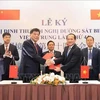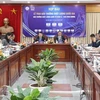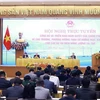 More than 35 leading Vietnamese manufacturers of garments, textiles and fashion accessories participated in the Global Sources Lifestyle and Fashion show in Hong Kong last week. (Source: VNA)
More than 35 leading Vietnamese manufacturers of garments, textiles and fashion accessories participated in the Global Sources Lifestyle and Fashion show in Hong Kong last week. (Source: VNA) Hanoi (VNS/VNA) - Vietnamese manufacturers need “integrated marketing solutions” comprising both online and offline platforms to gain access to buyers in both traditional and emerging markets, experts have said.
Speaking on the sidelines of the Global Sources Lifestyle and Fashion show last week in Hong Kong, Ronald Ng, general manager of Global Sources Lifestyle Group, said Vietnam had become a manufacturing hub in the Southeast Asian region.
Vietnamese exporters, mostly SMEs, who benefit from operating in one of the world’s fastest growing economies with stable governance and ease of doing business, are very likely to succeed in joining global trade.
To build their corporate image, generate sales leads and win orders from global buyers, Vietnamese suppliers should engage in more trade promotion platforms to strengthen linkages with global buyers.
“In addition to trade shows, online platforms are considered one of the most effective [ways] for them to boost exports to global markets,” he said.
Since China has moved up the manufacturing value chain, a significant number of international buyers now consider Vietnam an alternative supply market.
The number of orders shifting from China to Vietnam has increased remarkably.
“The price advantage is becoming less obvious while the gap in export communication between global buyers and suppliers is growing.”
Online platforms are the most convenient channel, providing year-round exposure for buyers to check and learn about suppliers’ capability and then submit online inquiries.
Meanwhile, offline platforms enable suppliers and buyers to meet face-to-face and gain credibility.
“Combined, online-to-offline (O2O) is the most comprehensive marketing mix for Vietnamese suppliers to win more business.”
A recent survey by Global Sources, the event organiser, found that 80 percent of global buyers preview product and supplier information online before they decide to go to the show to meet with targeted suppliers.
Swandi Wikassa, a buyer from Indonesia, said: “Before coming to the show for sourcing, we spent a great deal of time learning about the product and supplier online.”
According to Pham Thi Huong, former managing director of Vietnam National Textile and Garment Group (Vinatex), many Vietnamese products have good quality and competitive prices, but global buyers are not even aware of them since they are not available online.
“Participation in exhibitions helps Vietnamese suppliers promote their products, but it is not enough. They should also look to promote their products via online platforms to reach more global buyers.”
Manufacturers should also study prices, consumer tastes and trends in potential markets, and have labels and packaging in English and the local language, she said.
To meet the requirements of global buyers, Vietnamese manufactures should also focus on building brands, using technology in production and improving designs, she added.
Experts said in choosy markets like the US, the EU, Japan, and the Republic of Korea, exporters should be prepared to face technical barriers that could change unexpectedly.
A number of Vietnamese SMEs have little experience in digital or online marketing and lack information about the field and quality human resources, according to the experts.
More than 35 leading Vietnamese manufacturers of garments, textiles and fashion accessories and garment-related industries, many members of the Vietnam Textile and Apparel Association and Vinatex, participated in the show.
Last year, Vietnam’s textile and apparel exports were worth 36 billion USD, up 16 percent year-on-year, making the country one of the world’s three largest exporters.
The sector has set itself a target of 40 billion USD for this year and more than 60 billion USD by 2025.
The country’s economic growth is forecast to be 7.05 percent for this year on the back of robust FDI and manufacturing exports, according to the Vietnam Institute for Economic and Policy Research.
The Hong Kong expo was organised by Global Sources, a B2B platform that connects buyers and suppliers online and offline.
The platform includes more than 1.5 million global buyers, including 94 of the world’s top 100 retailers, in more than 190 countries and territories./.
VNA
